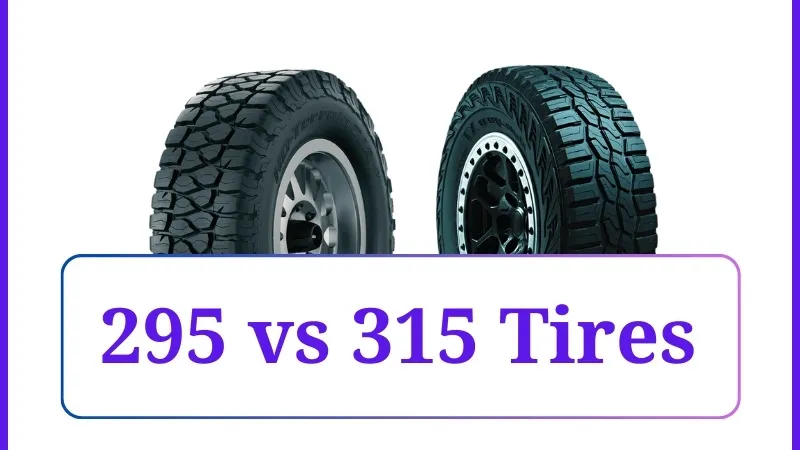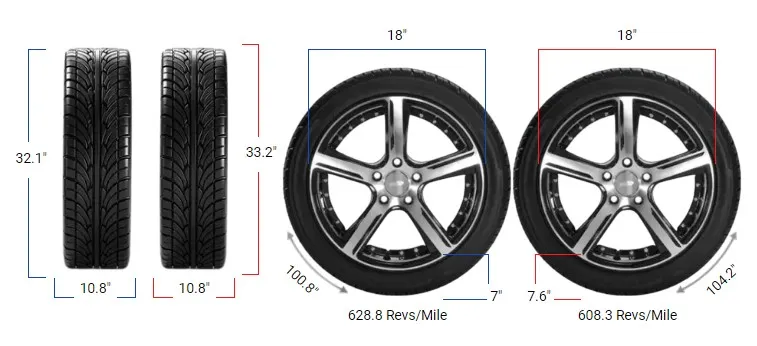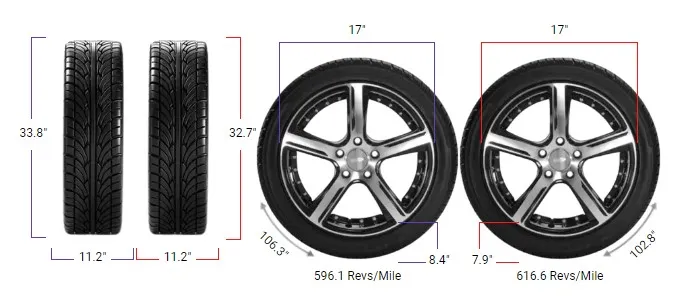295 vs 315 Tires

The key difference between 295 and 315 tires lies in their width. The 315 tires is about 20 mm wider than the 295 tires. The 315 tire is noticeably wider than the 295, providing a more aggressive look and enhancing contact with the road surface.
This increased contact can offer better traction, but there are other aspects to consider, including fitment, vehicle type, and driving conditions.
A wider tire, like the 315, offers improved grip, especially in off-road or performance situations, while the 295 can provide a more balanced approach that works well in a wider range of scenarios.
The switch between these sizes will impact your vehicle’s handling, fuel efficiency, and overall performance.
295 vs 315 Tires
This detailed tire size analysis assesses diameter differences by percentage and if interchangeability is possible.
| Tire Pair | Difference | Interchangeable |
|---|---|---|
| 295/70r17 vs 315/70r17 | +3.31% | No |
| 295/75r16 vs 315/75r16 | +3.48% | No |
| 295/40r21 vs 315/40r21 | +2.08% | Yes |
| 315/50r20 vs 295/55r20 | +1.17% | Yes |
| 315/70r17 vs 295/70r17 | -3.21% | No |
| 315/70r17 vs 295/70r18 | -0.30% | Yes |

Fitment Guide
It’s essential to ensure compatibility with your vehicle’s rims and to keep safety as a top priority. Here are the two conditions that must be met for a successful swap:
1. Ideal Rim Width Range Overlap: The ideal rim width range for 295 tires is 9.5, 10.0, 10.5, and 11.0 inches, while the range for 315 tires is 10.0, 10.5, 11.0, and 11.5 inches.
As you can see, there is an overlap in the ideal rim widths, which means switching between these tire sizes is possible in terms of fitment.
The overlap ensures that both tire sizes can be mounted on rims ranging from 10.0 to 11.0 inches, offering a good balance of performance, safety, and comfort.
2. Aspect Ratio and Rim Diameter: For a safe tire swap, the aspect ratio and rim diameter of the new tire should match those of the current tire. Alternatively, the overall diameter difference between the two sizes should not exceed 3%.
If the overall diameter difference is greater than this, it could significantly impact handling, braking, and speedometer accuracy, making it unsafe to proceed with the switch.

On-Road Impact
Switching from a 295 to a 315 tire has notable effects on road performance. The wider contact patch of a 315 tire provides increased grip, which is particularly advantageous during high-speed cornering or when driving on loose surfaces.
This added stability makes the 315 tire an appealing option for those who prioritize performance and handling. However, this added width also comes with some drawbacks. Wider tires often lead to increased rolling resistance, which can reduce fuel efficiency.
The 315 tire may also feel less responsive on tight turns compared to a narrower 295, and there could be additional road noise, making your ride less comfortable on highways.

Off-Road Impact
For off-road enthusiasts, upgrading to 315 tires can provide a significant advantage. The wider footprint improves traction on loose, rocky, or muddy terrains, allowing for better control and a more stable ride.
This can be crucial for tackling challenging trails where maximum grip is needed. However, a wider tire can also struggle in very narrow trails or heavily rutted areas.
The larger footprint means that your vehicle might not fit into certain off-road tracks, limiting maneuverability. In addition, the increased width can contribute to increased wear on steering and suspension components, especially if the terrain is extremely rough.
Pros of Switching to 315 Tires
- Increased Traction: The wider surface area offers better grip on both paved and off-road surfaces.
- Improved Stability: A wider tire can provide a more planted feel, particularly during high-speed maneuvers.
- Enhanced Off-Road Capability: If you spend a lot of time off the beaten path, the 315 can offer improved traction on challenging terrains.
Cons of Switching to 315 Tires
- Reduced Fuel Efficiency: The increased rolling resistance of a wider tire can lead to higher fuel consumption.
- Potential Fitment Issues: Depending on the suspension setup, a wider tire may require adjustments to prevent rubbing.
- Increased Wear on Components: Wider tires can exert additional strain on the steering, suspension, and other components, potentially leading to premature wear.

Pros of Staying with 295 Tires
- Better Fuel Economy: With less rolling resistance, 295 tires are more efficient, helping you save on fuel costs over time.
- Balanced Handling: A slightly narrower tire like the 295 may provide quicker and more responsive steering, which is beneficial for everyday driving.
- Reduced Component Strain: Maintaining a narrower tire can help prolong the life of your vehicle’s steering and suspension components by reducing strain.
Cons of Staying with 295 Tires
- Reduced Off-Road Traction: For those who take their vehicles off-road frequently, the 295 may not provide as much grip as the 315, potentially limiting capability on loose surfaces.
- Less Aggressive Appearance: A narrower tire may not offer the same bold, aggressive look that many drivers seek, especially on larger trucks or SUVs.
Difference Between 295 and 315 Tires
The main difference between 295 and 315 tires is their width. The 315 tires are 20 mm wider than 295 tires. The increased width of the 315 tire may affect traction and handling characteristics.

Can I Use 295 Tires Instead of 315?
Yes, you can use 295 tires instead of 315 tires if the ideal rim widths overlap and the aspect ratio and rim diameter are the same.
Since both tires share ideal rim widths between 10.0″ and 11.0″, swapping is feasible. Ensure that the overall diameter difference is within 3% to maintain performance and safety.
Can I Use 315 Tires Instead of 295?
Yes, you can use 315 tires instead of 295 tires if they share overlapping ideal rim widths and have the same aspect ratio and rim diameter.
The overlap between 10.0″ and 11.0″ rim widths allows for this substitution. Verify that the overall diameter difference doesn’t exceed 3% to ensure proper fit and function.
Can You Put 295 Tires on 315 Rims?
Yes, you can put 295 tires on rims designed for 315 tires if the rim width falls within the overlapping ideal range of 10.0″ to 11.0″.
Make sure the aspect ratio and rim diameter match, or that the overall diameter difference is within 3%, to maintain safety and performance standards.
Can You Put 315 Tires on 295 Rims?
Yes, installing 315 tires on rims meant for 295 tires is possible if the rim width is within the shared ideal range of 10.0″ to 11.0″.
Ensure that the aspect ratio and rim diameter are the same, or that any overall diameter difference is within 3%, to ensure compatibility and safety.
Our Observation
Switching from a 295 to a 315 tire brings both opportunities and challenges. If you’re seeking enhanced stability and off-road capability, the 315 is likely the better choice.
It provides better traction on challenging terrains and a more aggressive stance. However, if fuel efficiency, quick handling, and reducing wear on your vehicle are priorities, sticking with the 295 might be more practical.
The decision ultimately depends on your driving needs—whether you prioritize performance and grip or efficiency and comfort.



